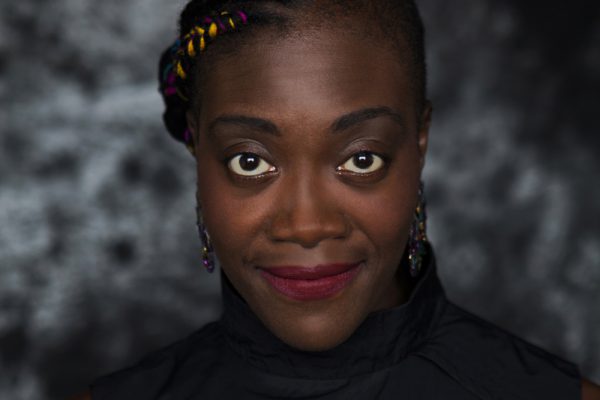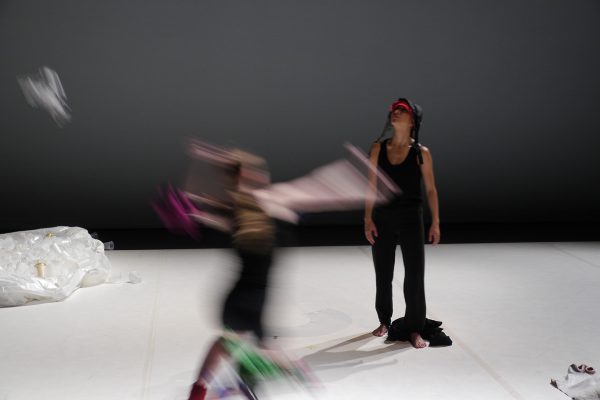It is understandable Jennifer Mascall’s imagination was ignited by Heinrich Harrer, one of the 20th century’s most famous European mountain climbers and adventurers. Harrer’s 1959 book, “The White Spider”, employs a philosophical tone to describe the many attempts and tragedies on the North Face of the Eiger, a 4,000-metre peak in the Swiss Alps. Mascall’s newest dance creation, named after Harrer’s book, premiered at the Roundhouse Community Arts and Recreation Centre as part of the Vancouver International Dance Festival during the 2010 Cultural Olympiad.
The North Face is 1,800 metres of vertical rock and ice, crevasses, cracks, and narrow chimney passages that have taken the lives of many highly skilled climbers, and in the 1930s represented one of the last frontier summits extreme climbers had not yet scaled. Above the massive rock face known as the Eiger Wall waits the “White Spider”, a gigantic ice field in the shape of a spider’s body with many snow-filled crevasses extending like slender legs in all directions. It is impossible to reach the summit without crossing the Spider, a treacherous sheet of ice that funnels sweeping avalanches, falling boulders, and howling winds. On July 24, 1938, Harrer, with a party of three other men, made the first successful ascent over the terrifying Spider and reached the summit.
Mascall’s choreography seeks to honour the death-defying manoeuvres, impossible decisions, and enormous strength men and women enacted climbing the North Face. She does so in an unpredictable style, working with a form of abstract storytelling that verbally references Harrer’s narrative, but always privileging the movement first.
Act one opens with Alisoun Payne in a white, full-skirted dress, climbing harness around her pelvis, stepping slowly on the top edge of a large white disc positioned upstage right. The disc, representing the Spider, revolves slowly so that Payne’s gorgeous image appears to float at the top of the world. Sasha Klapkiw enters carrying a duffel bag, and Clinton Draper moves across the downstage in a straight line, changing levels and turning around himself with upper body spirals; both men are dressed in white pants and tops. Brandy Baybutt, in a white crinoline skirt, lies on the disc feet first, as though braking a slide.
Catherine Hahn’s unexpectedly feminine costume design contributes to the striking theatrical effect that Mascall and her artistic team achieve: an overwhelming brilliant whiteness that transports viewers’ senses to high-altitude, snow-covered mountainsides. Lighting design by the always dazzling James Proudfoot and the otherworldly sound composition by Jeff Corness support and translate the movement choices. Throughout, Corness incorporates a sorrowful, female voice with Asian musical styling, which relates nicely to Harrer’s climbing expeditions in the Himalayas, documented in the book “Seven Years in Tibet”. The score, beautiful on its own, guides the progression of the work, offering tremendous diversity, from abstract, drone-like atmospheric texture to sound effects of crusty snow, swirling wind, and crashing avalanches. In addition, Candelario Andrade and Tim Matheson conspire with projected images of mountain peaks on the back stage wall seen from the perspective of dizzying height.
The four dancers move in their own worlds for a while, experimenting with movement on several climbing ropes that hang from the exposed flyspace. An arm with a furry white muff reaches out of the bag Klapkiw had set down earlier, and a fifth dancer, Ziyian Kwan, sporting a white fur hat and white shorts, wriggles out of the bag, introducing humour. The act develops through a progression of rotating duets, trios, solos, and brief moments of unison movement, weight transfers, leans, falls to the floor, low crawls, and squats. Klapkiw and Baybutt attach their harnesses to the long, suspended ropes, swinging and dangling low off the floor, an expanse of imaginary sky and rock face below them. Kwan moves in close to Klapkiw, facing him, and he lifts her body over his shoulder in a smooth arc, so that for a few seconds she is almost airborne. Several times they come together and repeat this wonderful lift, a deep kinetic metaphor transmitting the essence of connection between mountain climbers.
In another scene, all five dancers balance on the Spider-disc, leaning forward in a low stance, slipping back, running on the uphill grade, windmill arms rotating their bodies in full turns over and over, the top of the “icy” disc perpetually out of reach. Standing, the five move as one, bodies swaying, shoulders slumped against each other. At other moments, the performers separate into distinct groupings as if in different, simultaneous worlds. For example, Baybutt and Payne harness up side-by-side, and hang upside down, fingers and toes perceptibly alive, while Klapkiw lays upside down across the disc, and Draper and Kwan look through binoculars. “I see a foothold,” says Draper. Mascall is expert at managing a series of ever-changing movement combinations that hold our attention with their multiple foci, and then suddenly transmuting the many points into a quirky micro-solo.
The white brilliance vanishes in act two, replaced by a darker mood, and the addition of set designer and sculptor Alan Storey’s huge kite-shaped, metal-frame structure that occupies the centre of the stage and ingeniously brings the vertical rock wall of the North Face to the theatre. The sides are constructed as ladder rungs and while the base is stable, the corner joints allow the entire frame to sway, threatening collapse. The dancers enter in semi-darkness, single file, wearing lit headlamps and shorts and shirts in greys and browns. They clamber over the structure, sliding to the other side, with the exception of Kwan who has difficulty due to her four-inch spiked high heels, so Klapkiw gathers her up and carries her over. Although Kwan performs this kind of caricature well and the absurdity gets laughs, the fullness of the work does not need the insertion of parody. Later, Kwan sits in a chair, while Thoenn Glover, a sixth performer who appears occasionally, puts clothes pegs throughout Kwan’s hair, finishing by fastening one to her lip. In this instance, the absurdity of the creative choice evokes curiosity and bodily identification, because the somatic effect resonated a felt sense of frostbite for me. Throughout the second act, Mascall’s recorded voice narrates short excerpts from Harrer’s book, giving just enough story to cue viewers to the formidable conditions on the Face: “an avalanche of ice”, “blowing wind”, and “a frozen arm”. The only way up is through narrow, restrictive rock chimneys and cracks. “You have to do it,” says one of the dancers. “I can’t.” “You have to.”
Mascall employs aerial dancing judiciously and some memorable moments of height include Klapkiw and Draper dropping suddenly headfirst, bodies suspended upside down on ropes, and Payne, an experienced aerial dancer, sailing and sweeping like a bird at the top of the theatre. Julia Taffe, artistic director of the vertical dance company Aeriosa, mentored Mascall with the challenges of aerial movement.
The final scene of “The White Spider” is powerful as all six dancers face the audience in a horizontal line downstage. Mascall narrates the account of a climber’s endless hip pain as he spends nights alone on a cold rock ledge. Each dancer touches a different part of their own body, voicing words quietly, and we feel the universal vulnerability of the human body. “The White Spider” reminds us all that our experiences in the world are mediated by the capacity of the body, but some individuals are driven to push the outermost edges of that capacity.
Tagged: Aerial, Contemporary, Performance, BC





